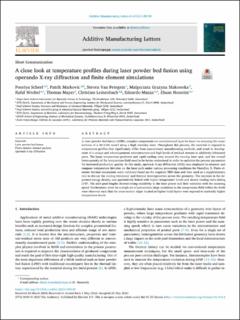Please use this identifier to cite or link to this item:
https://doi.org/10.21256/zhaw-29350Full metadata record
| DC Field | Value | Language |
|---|---|---|
| dc.contributor.author | Scheel, Pooriya | - |
| dc.contributor.author | Markovic, Patrik | - |
| dc.contributor.author | Van Petegem, Steven | - |
| dc.contributor.author | Makowska, Malgorzata Grazyna | - |
| dc.contributor.author | Wrobel, Rafal | - |
| dc.contributor.author | Mayer, Thomas | - |
| dc.contributor.author | Leinenbach, Christian | - |
| dc.contributor.author | Mazza, Edoardo | - |
| dc.contributor.author | Hosseini, Ehsan | - |
| dc.date.accessioned | 2023-12-08T15:03:58Z | - |
| dc.date.available | 2023-12-08T15:03:58Z | - |
| dc.date.issued | 2023 | - |
| dc.identifier.issn | 2772-3690 | de_CH |
| dc.identifier.uri | https://digitalcollection.zhaw.ch/handle/11475/29350 | - |
| dc.description.abstract | In laser powder bed fusion (LPBF), complex components are manufactured layer-by-layer via scanning the cross-sections of a 3D CAD model using a high intensity laser. Throughout this process, the material is exposed to temperature profiles that significantly differ from conventional manufacturing methods, and result in development of a unique and inhomogeneous microstructure and high levels of residual stresses in additively fabricated parts. The large temperature gradients and rapid cooling rates around the moving laser spot, and the overall heterogeneity of the temperature field need to be better understood in order to optimize the process parameters for increased production quality. In this study, operando X-ray diffraction (XRD) was employed to measure and compare temperature histories on the laser path under various processing conditions for Hastelloy X. Finite element thermal simulations were validated based on the acquired XRD data and then used as a supplementary tool to discuss the cooling behaviour and thermal heterogeneities across the geometry. The increase in the deposited energy density was qualitatively linked with higher temperature levels and slower cooling rates during LPBF. The melt-pool lengths showed strong sensitivity to the laser power and little variation with the scanning speed. Furthermore, even for a single set of parameters, large variations in the temperature field within the build were observed such that the cross-section edges located at higher build layers were exposed to markedly higher temperature levels. | de_CH |
| dc.language.iso | en | de_CH |
| dc.publisher | Elsevier | de_CH |
| dc.relation.ispartof | Additive Manufacturing Letters | de_CH |
| dc.rights | https://creativecommons.org/licenses/by/4.0/ | de_CH |
| dc.subject | Laser powder bed fusion | de_CH |
| dc.subject | Finite element thermal analysis | de_CH |
| dc.subject | Operando X-ray diffraction | de_CH |
| dc.subject.ddc | 670: Industrielle und handwerkliche Fertigung | de_CH |
| dc.title | A close look at temperature profiles during laser powder bed fusion using operando X-ray diffraction and finite element simulations | de_CH |
| dc.type | Beitrag in wissenschaftlicher Zeitschrift | de_CH |
| dcterms.type | Text | de_CH |
| zhaw.departement | School of Engineering | de_CH |
| zhaw.organisationalunit | Institut für Mechanische Systeme (IMES) | de_CH |
| dc.identifier.doi | 10.1016/j.addlet.2023.100150 | de_CH |
| dc.identifier.doi | 10.21256/zhaw-29350 | - |
| zhaw.funding.eu | No | de_CH |
| zhaw.issue | 100150 | de_CH |
| zhaw.originated.zhaw | Yes | de_CH |
| zhaw.publication.status | publishedVersion | de_CH |
| zhaw.volume | 6 | de_CH |
| zhaw.publication.review | Peer review (Publikation) | de_CH |
| zhaw.funding.snf | 200551 | de_CH |
| zhaw.webfeed | Additive Manufacturing | de_CH |
| zhaw.webfeed | MM Mechanics for Modelling | de_CH |
| zhaw.author.additional | No | de_CH |
| zhaw.display.portrait | Yes | de_CH |
| Appears in collections: | Publikationen School of Engineering | |
Files in This Item:
| File | Description | Size | Format | |
|---|---|---|---|---|
| 2023_Scheel-etal_Temperature-profiles-during-LPBF.pdf | 2.29 MB | Adobe PDF |  View/Open |
Show simple item record
Scheel, P., Markovic, P., Van Petegem, S., Makowska, M. G., Wrobel, R., Mayer, T., Leinenbach, C., Mazza, E., & Hosseini, E. (2023). A close look at temperature profiles during laser powder bed fusion using operando X-ray diffraction and finite element simulations. Additive Manufacturing Letters, 6(100150). https://doi.org/10.1016/j.addlet.2023.100150
Scheel, P. et al. (2023) ‘A close look at temperature profiles during laser powder bed fusion using operando X-ray diffraction and finite element simulations’, Additive Manufacturing Letters, 6(100150). Available at: https://doi.org/10.1016/j.addlet.2023.100150.
P. Scheel et al., “A close look at temperature profiles during laser powder bed fusion using operando X-ray diffraction and finite element simulations,” Additive Manufacturing Letters, vol. 6, no. 100150, 2023, doi: 10.1016/j.addlet.2023.100150.
SCHEEL, Pooriya, Patrik MARKOVIC, Steven VAN PETEGEM, Malgorzata Grazyna MAKOWSKA, Rafal WROBEL, Thomas MAYER, Christian LEINENBACH, Edoardo MAZZA und Ehsan HOSSEINI, 2023. A close look at temperature profiles during laser powder bed fusion using operando X-ray diffraction and finite element simulations. Additive Manufacturing Letters. 2023. Bd. 6, Nr. 100150. DOI 10.1016/j.addlet.2023.100150
Scheel, Pooriya, Patrik Markovic, Steven Van Petegem, Malgorzata Grazyna Makowska, Rafal Wrobel, Thomas Mayer, Christian Leinenbach, Edoardo Mazza, and Ehsan Hosseini. 2023. “A Close Look at Temperature Profiles during Laser Powder Bed Fusion Using Operando X-Ray Diffraction and Finite Element Simulations.” Additive Manufacturing Letters 6 (100150). https://doi.org/10.1016/j.addlet.2023.100150.
Scheel, Pooriya, et al. “A Close Look at Temperature Profiles during Laser Powder Bed Fusion Using Operando X-Ray Diffraction and Finite Element Simulations.” Additive Manufacturing Letters, vol. 6, no. 100150, 2023, https://doi.org/10.1016/j.addlet.2023.100150.
Items in DSpace are protected by copyright, with all rights reserved, unless otherwise indicated.